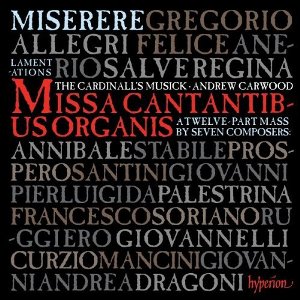Album review: Dufay and the Court of Savoy
Hyperion CDA67715
Originally written for Musicalcriticism.com
The mid fifteenth-century Savoy Court is the basis for this disc of Dufay's music from The Binchois Consort, an all-vocal ensemble directed by Andrew Kirkman. Built around the Missa Se la face ay pale, interspersed with Propers for a particular Saints Day and topped off by two motets and a song, all of these works have strong connections to the Savoy Court making for a delightful and insightful selection which is accompanied by excellent sleeve-notes and translations.
That this mass has been recorded several times since the early music revival of the '60s and '70s, is testament to just how good it is and, as one of the earliest masses based on a cantus firmus, how interesting it is. By the time Dufay wrote this mass his song from which the tenor is taken seems to have achieved great popularity and his influence as a composer is suggested by the fact that this and his three subsequent four-part mass cycles are at the beginnings of what became a long-established tradition for great composers to set the mass ordinary. A situation which lasted right up to the seventeenth century.
This recording is everything that we have come to expect from the Binchois Consort. It is beautifully paced and delivered with a clear and luminous texture. French pronunciation engenders an attractive zing in the voices and these slightly exotic-sounding vowels are well balanced between each singer. Throughout the wide range of styles in these works the consort always negotiate the music with an insightful portrayal of the texts whilst maintaining their fluent style.
The real gem of this recording though is left until the penultimate track when we hear the song Se la face ay pale elaborated into a four part setting, probably by Dufay, rather than the three part version which is more often heard. Here the singers are at their very best, especially the countertenors; a finer performance than this I cannot imagine.
I am, however, somewhat disappointed that for this recording they have not chosen to revisit the more generous acoustic that so characterized their award-winning Music for St James the Greater (Hyperion GAW21997). That older recording had a sense of enchantment that is definitely lacking from this latest release where the emphasis seems to have migrated towards immediacy.
It is true to say that we have become used to a certain ethereal distance in recordings of Dufay, especially from groups such as Pomerium and The Huelgas Ensemble. Also The Hilliard Ensemble used quite a resonant acoustic for their excellent (live) disc of this very mass back in 1998. I feel that certain parts of the Mass Ordinary movements in this latest recording would benefit from being able to hear more of the building since theacoustic as it stands is not very flattering to the two countertenors when they are singing in unison; when, through no fault of their own, they often made to sound a little reedy. A more generous building would have portrayed a softer sound at such moments. However, when The Binchois Consort sing the motet Magnanime gentis soft blend is less of an issue due to the stylistic difference of the music, illustrating just how a delicate a matter this is.
For those who already own one or two recordings of the mass, I can only say that the song and motets on this release are well worth the investment on their own: they are beautifully sung and as a programme this selection of Dufay's works is distinctly more-ish. The Binchois Consort have given us a hugely valuable addition to our understanding of Dufay and I should recommend it to anyone interested in exploring this repertoire further. I'm looking forward to future recordings from this exciting ensemble.


